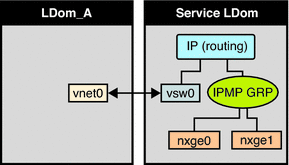Configuring IPMP in the Service Domain
In Logical Domains releases prior to 1.3, the virtual switch device is not capable of physical link failure detection. In such cases, network failure detection and recovery can be set up by configuring the physical interfaces in the service domain into an IPMP group. To do this, configure the virtual switch in the service domain without assigning a physical network device to it. Namely, do not specify a value for the net-dev (net-dev=) property while you use the ldm add-vswitch command to create the virtual switch. Plumb the virtual switch interface in the service domain and configure the service domain itself to act as an IP router. Refer to the Solaris 10 System Administration Guide: IP Services for information on setting up IP routing.
Once configured, the virtual switch sends all packets originating from virtual networks (and destined for an external machine) to its IP layer, instead of sending the packets directly by means of the physical device. In the event of a physical interface failure, the IP layer detects failure and automatically re-routes packets through the secondary interface.
Since the physical interfaces are directly being configured into an IPMP group, the group can be set up for either link-based or probe-based detection. The following diagram shows two network interfaces (nxge0 and nxge1) configured as part of an IPMP group. The virtual switch instance (vsw0) has been plumbed as a network device to send packets to its IP layer.
Figure 7–6 Two Network Interfaces Configured as Part of IPMP Group

 Configure a Host Route for Probe-Based IPMP
Configure a Host Route for Probe-Based IPMP
Note –
This procedure only applies to guest domains and to releases prior to 1.3, where only probe-based IPMP is supported.
If no explicit route is configured for a router in the network corresponding to the IPMP interfaces, then one or more explicit host routes to target systems need to be configured for the IPMP probe-based detection to work as expected. Otherwise, probe detection can fail to detect the network failures.
-
Configure a host route.
# route add -host destination-IP gateway-IP -static
For example:
# route add -host 192.168.102.1 192.168.102.1 -static
Refer to Configuring Target Systems in System Administration Guide: IP Services for more information.
- © 2010, Oracle Corporation and/or its affiliates
